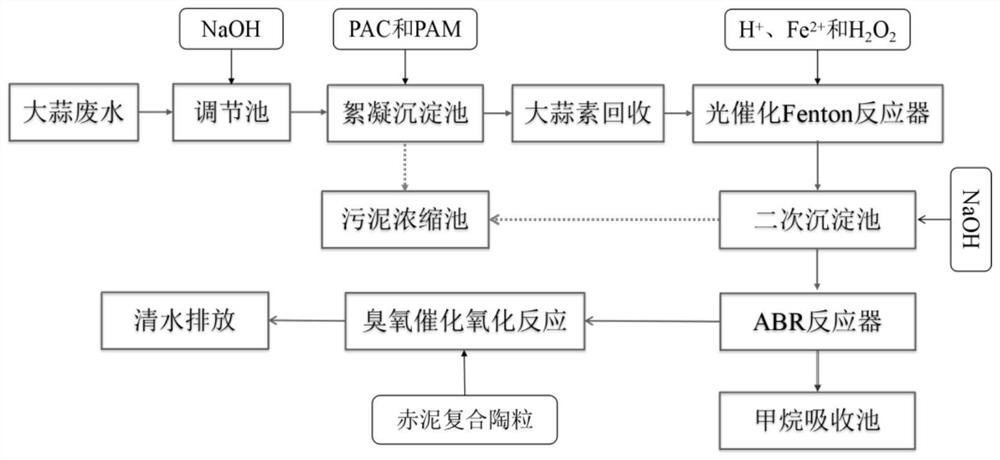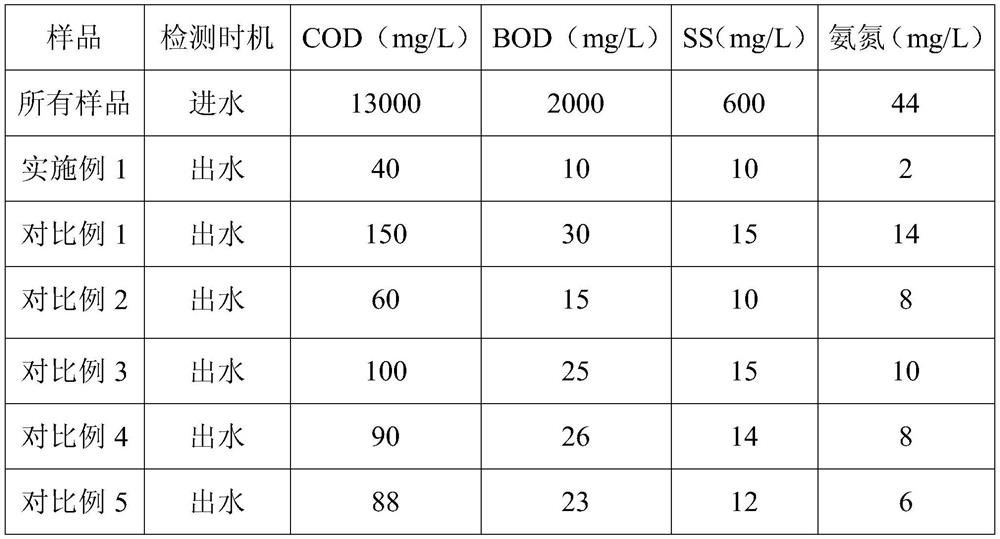A kind of treatment method of garlic processing wastewater
A technology of garlic processing wastewater and treatment method, which is applied in the directions of food industry wastewater treatment, energy wastewater treatment, water/sewage treatment, etc. Treatment cost and effect of preventing sludge loss
- Summary
- Abstract
- Description
- Claims
- Application Information
AI Technical Summary
Problems solved by technology
Method used
Image
Examples
Embodiment 1
[0029] The process of treating wastewater from garlic processing in a factory is as follows:
[0030] (1) Add sodium hydroxide in the adjustment tank to adjust the pH value of garlic processing wastewater to 7-8 and then send it to a flocculation sedimentation tank with a flocculant added for treatment. The flocculant is polyaluminum chloride and polyacrylamide. The dosage ratio is 1:2.5, the dosage of flocculant per 1L of wastewater is 0.05mg, and the obtained flocculation sediment is sent to the sludge thickening tank;
[0031] (2) in the waste water after above-mentioned steps (1) processing, add compound extractant and carry out the recovery of allicin, the consumption of compound extractant is 50ml / L, and described compound extractant is made of tributyl phosphate, trioctyldecane It is composed of base tertiary amine and diluent n-octanol, and the weight ratio of tributyl phosphate and trioctyldecyl tertiary amine is 1:1. Taking the mixture of tributyl phosphate and trioc...
Embodiment 2
[0037] The process of treating wastewater from garlic processing in a factory is as follows:
[0038] (1) Add sodium hydroxide in the adjustment tank to adjust the pH value of the garlic processing wastewater to 8 and then send it to the flocculation sedimentation tank added with flocculants for treatment. The flocculants are polyaluminum chloride and polyacrylamide, and the proportion of the two 1:5, the amount of flocculant per 1L of wastewater is 20mg, and the obtained flocculation sediment is sent to the sludge thickening tank;
[0039] (2) in the waste water after above-mentioned steps (1) is processed, add compound extractant and carry out the recovery of allicin, the consumption of compound extractant is 50ml / L, and compound extractant is composed of tributyl phosphate, trioctyldecyl tertiary It is composed of amine and diluent chloroform, the weight ratio of tributyl phosphate and trioctyldecyl tertiary amine is 1:3, taking the mixture of tributyl phosphate and triocty...
Embodiment 3
[0045] The process of treating wastewater from garlic processing in a factory is as follows:
[0046] (1) Add sodium hydroxide in the adjustment tank to adjust the pH value of the garlic processing wastewater to 8 and then send it to the flocculation sedimentation tank added with flocculants for treatment. The flocculants are polyaluminum chloride and polyacrylamide, and the proportion of the two is 1:10, the dosage of flocculant per 1L of wastewater is 30mg, and the obtained flocculation sediment is sent to the sludge thickening tank;
[0047] (2) in the waste water after above-mentioned steps (1) is processed, add compound extractant and carry out the recovery of allicin, the consumption of compound extractant is 50ml / L, and compound extractant is composed of tributyl phosphate, trioctyldecyl tertiary Amine and diluent carbon tetrachloride, the weight ratio of tributyl phosphate and trioctyldecyl tertiary amine is 1:5, taking the mixture of tributyl phosphate and trioctyldec...
PUM
| Property | Measurement | Unit |
|---|---|---|
| particle diameter | aaaaa | aaaaa |
| particle diameter | aaaaa | aaaaa |
Abstract
Description
Claims
Application Information
 Login to View More
Login to View More - R&D
- Intellectual Property
- Life Sciences
- Materials
- Tech Scout
- Unparalleled Data Quality
- Higher Quality Content
- 60% Fewer Hallucinations
Browse by: Latest US Patents, China's latest patents, Technical Efficacy Thesaurus, Application Domain, Technology Topic, Popular Technical Reports.
© 2025 PatSnap. All rights reserved.Legal|Privacy policy|Modern Slavery Act Transparency Statement|Sitemap|About US| Contact US: help@patsnap.com



